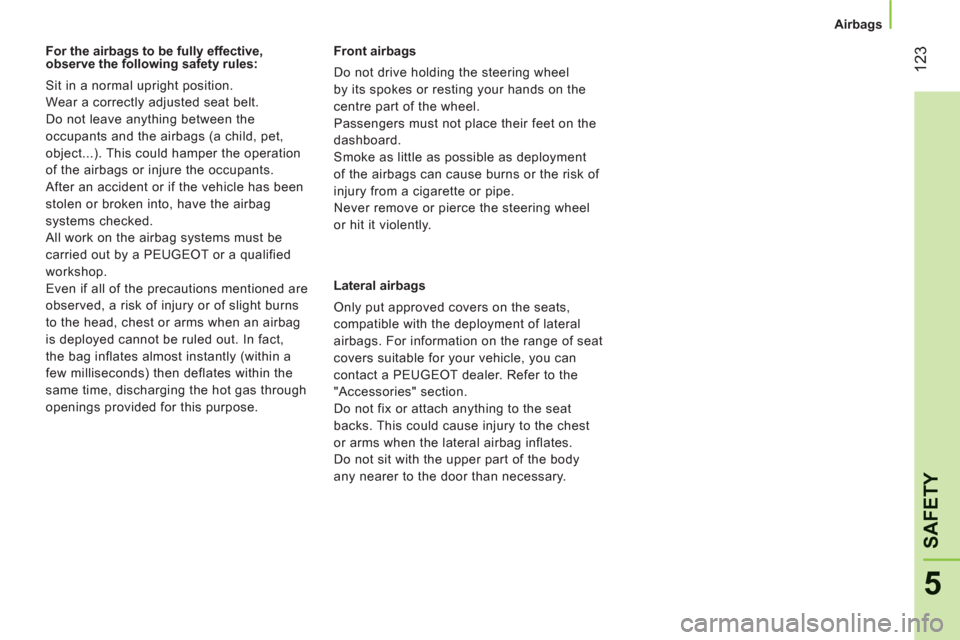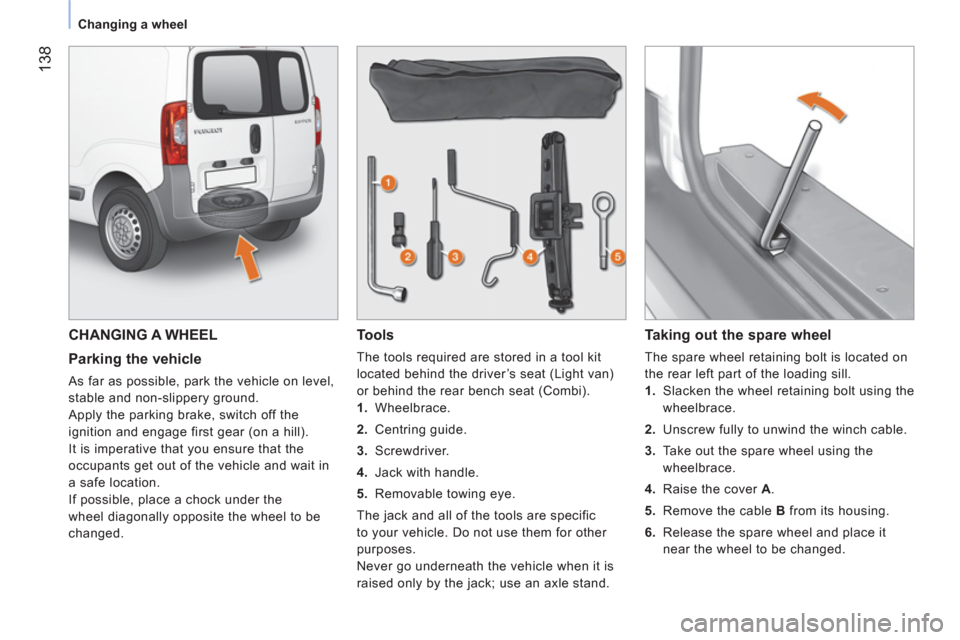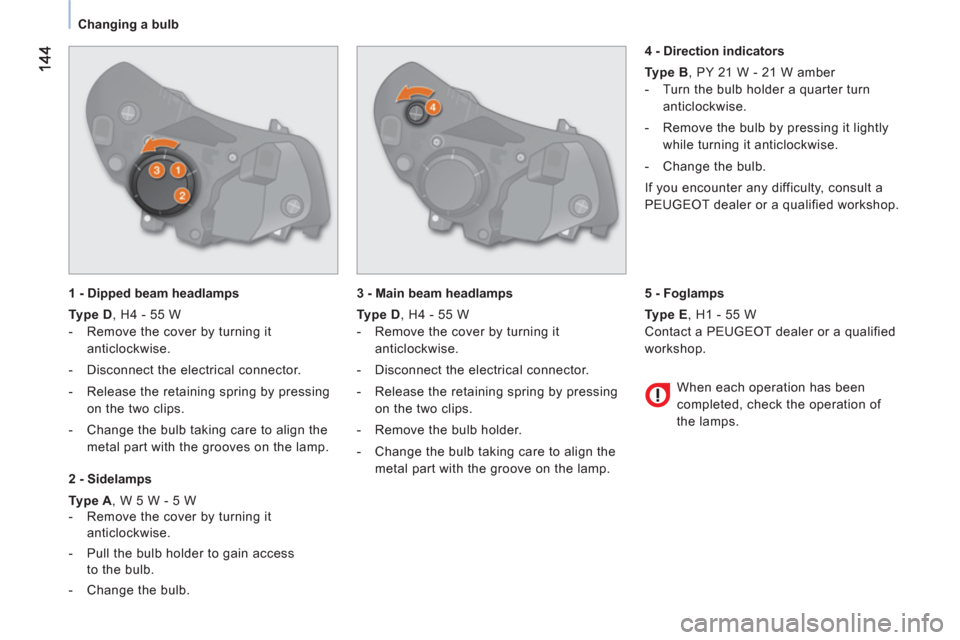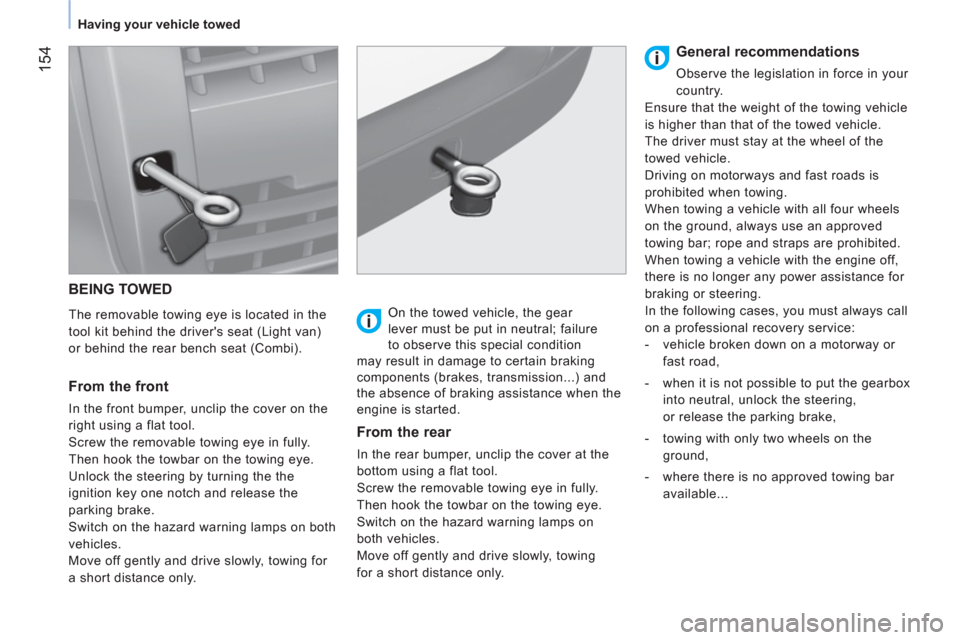Page 125 of 180

12
3
5
SAFETY
Airbags
For the airbags to be fully effective,
observe the following safety rules:
Sit in a normal upright position.
Wear a correctly adjusted seat belt.
Do not leave anything between the
occupants and the airbags (a child, pet,
object...). This could hamper the operation
of the airbags or injure the occupants.
After an accident or if the vehicle has been
stolen or broken into, have the airbag
systems checked.
All work on the airbag systems must be
carried out by a PEUGEOT or a qualified
workshop.
Even if all of the precautions mentioned are
observed, a risk of injury or of slight burns
to the head, chest or arms when an airbag
is deployed cannot be ruled out. In fact,
the bag inflates almost instantly (within a
few milliseconds) then deflates within the
same time, discharging the hot gas through
openings provided for this purpose.
Front airbags
Do not drive holding the steering wheel
by its spokes or resting your hands on the
centre part of the wheel.
Passengers must not place their feet on the
dashboard.
Smoke as little as possible as deployment
of the airbags can cause burns or the risk of
injury from a cigarette or pipe.
Never remove or pierce the steering wheel
or hit it violently.
Lateral airbags
Only put approved covers on the seats,
compatible with the deployment of lateral
airbags. For information on the range of seat
covers suitable for your vehicle, you can
contact a PEUGEOT dealer. Refer to the
"Accessories" section.
Do not fix or attach anything to the seat
backs. This could cause injury to the chest
or arms when the lateral airbag inflates.
Do not sit with the upper part of the body
any nearer to the door than necessary.
Page 128 of 180
12
6
Child safety
INSTALLING CHILD SEATS ATTACHED USING THE SEAT BELT (LIGHT VAN)
In accordance with European regulations, this table indicates the options for installing child seats secured using a seat belt and universally
approved in accordance with the weight of the child and the seat in the vehicle:
Weight of the child and indicative age
Seat
Under 13 kg
(groups 0 ( a ) and 0+)
Up to approx 1 year
From 9 to 18 kg
(group 1)
1 to 3 years approx
From 15 to 25 kg
(group 2)
3 to 6 years approx
From 22 to 36 kg
(group 3)
6 to 10 years approx
Front passenger
seat ( b )
U
U
U
U
a
: Group 0: from birth to 10 kg. Infant car seats and "car cots" cannot be installed on the front passenger seat.
b
:
consult the legislation in force in your country before installing your child on this seat.
U
:
seat suitable for the installation of a child seat secured using a seat belt and universally approved, "rear facing" and/or "forward facing".
Page 140 of 180

138
Changing a wheel
CHANGING A WHEEL
Parking the vehicle
As far as possible, park the vehicle on level,
stable and non-slippery ground.
Apply the parking brake, switch off the
ignition and engage first gear (on a hill).
It is imperative that you ensure that the
occupants get out of the vehicle and wait in
a safe location.
If possible, place a chock under the
wheel diagonally opposite the wheel to be
changed.
Tools
The tools required are stored in a tool kit
located behind the driver’s seat (Light van)
or behind the rear bench seat (Combi).
1.
Wheelbrace.
2.
Centring guide.
3.
Screwdriver.
4.
Jack with handle.
5.
Removable towing eye.
The jack and all of the tools are specific
to your vehicle. Do not use them for other
purposes.
Never go underneath the vehicle when it is
raised only by the jack; use an axle stand.
Taking out the spare wheel
The spare wheel retaining bolt is located on
the rear left part of the loading sill.
1.
Slacken the wheel retaining bolt using the
wheelbrace.
2.
Unscrew fully to unwind the winch cable.
3.
Take out the spare wheel using the
wheelbrace.
4.
Raise the cover A
.
5.
Remove the cable B
from its housing.
6.
Release the spare wheel and place it
near the wheel to be changed.
Page 146 of 180

Changing a bulb
1 - Dipped beam headlamps
Type D
, H4 - 55 W
- Remove the cover by turning it
anticlockwise.
- Disconnect the electrical connector.
- Release the retaining spring by pressing
on the two clips.
- Change the bulb taking care to align the
metal part with the grooves on the lamp.
2 - Sidelamps
Type A
, W 5 W - 5 W
- Remove the cover by turning it
anticlockwise.
- Pull the bulb holder to gain access
to the bulb.
- Change the bulb.
3 - Main beam headlamps
Type D
, H4 - 55 W
- Remove the cover by turning it
anticlockwise.
- Disconnect the electrical connector.
- Release the retaining spring by pressing
on the two clips.
- Remove the bulb holder.
- Change the bulb taking care to align the
metal part with the groove on the lamp.
4 - Direction indicators
Type B
, PY 21 W - 21 W amber
- Turn the bulb holder a quarter turn
anticlockwise.
- Remove the bulb by pressing it lightly
while turning it anticlockwise.
- Change the bulb.
If you encounter any difficulty, consult a
PEUGEOT dealer or a qualified workshop.
When each operation has been
completed, check the operation of
the lamps.
5 - Foglamps
Type E
, H1 - 55 W
Contact a PEUGEOT dealer or a qualified
workshop.
Page 152 of 180
150
Changing a fuse
Table of dashboard fuses, driver’s
side
Mark
ing
Rating
Functions
F12
7.5 A Right-hand dipped beam headlamp supply
F13
7.5 A Left-hand dipped beam headlamp supply - headlamp height
adjuster
F31
5 A Engine control unit supply switch
F32
7.5 A Front lamp - front courtesy lamp - rear courtesy light lamp
F36
10 A Audio system - mobile telephone pre-equipment -
air conditioning control panel - EODB diagnostic socket
F37
5 A Brake lamp - instrument panel
F38
20 A Door locking
F43
15 A Screenwash pump
F47
20 A Driver’s electric window motor supply
F48
20 A Passenger’s electric window motor supply
F49
5 A Parking sensors control unit - rear lighting switch - electric
door mirrors - volumetric alarm control unit
F50
7.5 A Airbags control unit
F51
7.5 A Switch on brake pedal - switch on clutch pedal - door mirror
controls - central Bluetooth system
F53
5 A Instrument panel - rear foglamps
Page 153 of 180
151
7
QUICK HEL
P
Changing a fuse
Marking
Rating
Functions
F41
7.5 A Door mirror demisting.
F94
15 A Cigar lighter.
F96
15 A 12 V accessory socket.
F97
10 A Heated seat, driver’s side.
F98
10 A heated seat, passenger’s side.
Page 155 of 180

153
7
QUICK HEL
P
Changing a fuse
Marking
Rating
Functions
F16
7.5 A Engine management control unit - electronic gearbox control unit and gear lever - T20 relay coil
F17
15 A Supply for ignition coil - injectors - engine management control unit (1.3 HDi)
F18
7.5 A Engine management control unit (1.3 HDi) - T09 relay coil
F19
7.5 A Air conditioning compressor
F20
30 A Supply for heated rear screen, electric door mirrors heater elements
F21
15 A Fuel pump (1.4 petrol and 1.3 HDi)
F22
20 A Engine management control unit (1.3 HDi)
F23
20 A ABS hydraulic block electrovalves supply
F24
7.5 A ABS
F30
15 A Foglamps
F81
60 A Pre-heat unit (1.3 HDi)
F82
30 A Electronic gearbox pump - electronic gearbox supply
F84
10 A Electronic gearbox control unit and electrovalves
F85
30 A Cigar lighter - 12 V accessory socket
F87
7.5 A
Reversing lamps - water in Diesel sensor - airflow sensor - T02, T05, T14, T17 and T19 relay coils
(except 1.3 HDi)
5 A Reversing lamps - water in Diesel sensor - airflow sensor - T02, T05, T14, T17 and T19 relay coils - battery
state of charge sensor (except 1.3 HDi)
Page 156 of 180

154
Having your vehicle towed
BEING TOWED
The removable towing eye is located in the
tool kit behind the driver's seat (Light van)
or behind the rear bench seat (Combi).
From the front
In the front bumper, unclip the cover on the
right using a flat tool.
Screw the removable towing eye in fully.
Then hook the towbar on the towing eye.
Unlock the steering by turning the the
ignition key one notch and release the
parking brake.
Switch on the hazard warning lamps on both
vehicles.
Move off gently and drive slowly, towing for
a short distance only.
On the towed vehicle, the gear
lever must be put in neutral; failure
to observe this special condition
may result in damage to certain braking
components (brakes, transmission...) and
the absence of braking assistance when the
engine is started.
From the rear
In the rear bumper, unclip the cover at the
bottom using a flat tool.
Screw the removable towing eye in fully.
Then hook the towbar on the towing eye.
Switch on the hazard warning lamps on
both vehicles.
Move off gently and drive slowly, towing
for a short distance only.
General recommendations
Observe the legislation in force in your
country.
Ensure that the weight of the towing vehicle
is higher than that of the towed vehicle.
The driver must stay at the wheel of the
towed vehicle.
Driving on motorways and fast roads is
prohibited when towing.
When towing a vehicle with all four wheels
on the ground, always use an approved
towing bar; rope and straps are prohibited.
When towing a vehicle with the engine off,
there is no longer any power assistance for
braking or steering.
In the following cases, you must always call
on a professional recovery service:
- vehicle broken down on a motorway or
fast road,
- when it is not possible to put the gearbox
into neutral, unlock the steering,
or release the parking brake,
- towing with only two wheels on the
ground,
- where there is no approved towing bar
available...